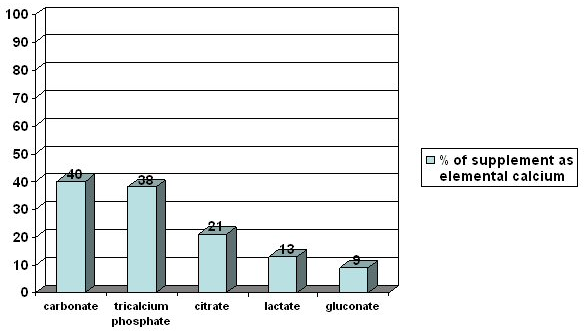12.2B: Calcium Bioavailability
- Page ID
- 1557
Calcium bioavailability varies greatly from food to food, as shown in the table below. This table gives the serving size, calcium content of that food, and percent absorbed. The calcium content is multiplied by the absorption percentage to calculate the estimated calcium absorbed. Finally, it shows the servings of each food needed to equal the estimated calcium absorbed from 1 serving of milk.
|
Food |
Serving Size (g) |
Calcium content (mg) |
Absorption (%) |
Estimated Calcium Absorbed |
Servings needed to equal 240 mL milk |
|---|---|---|---|---|---|
|
Cow’s Milk |
240 |
300 |
32.1 |
96.3 |
1.0 |
|
Almonds, dry roasted |
28 |
80 |
21.2 |
17.0 |
5.7 |
|
Beans, Pinto |
86 |
44.7 |
26.7 |
11.9 |
8.1 |
|
Beans, Red |
172 |
40.5 |
24.4 |
9.9 |
9.7 |
|
Beans, White |
110 |
113 |
21.8 |
24.7 |
3.9 |
|
Bok Choy |
85 |
79 |
53.8 |
42.5 |
2.3 |
|
Broccoli |
71 |
35 |
61.3 |
21.5 |
4.5 |
|
Brussel Sprouts |
78 |
19 |
63.8 |
12.1 |
8.0 |
|
Cabbage, Chinese |
85 |
79 |
53.8 |
42.5 |
2.3 |
|
Cabbage, Green |
75 |
25 |
64.9 |
16.2 |
5.9 |
|
Cauliflower |
62 |
17 |
68.6 |
11.7 |
8.2 |
|
Cheddar Cheese |
42 |
303 |
32.1 |
97.2 |
1.0 |
|
Chinese mustard greens |
85 |
212 |
40.2 |
85.3 |
1.1 |
|
Chinese spinach |
85 |
347 |
8.36 |
29 |
3.3 |
|
Fruit Punch (CCM) |
240 |
300 |
52 |
156 |
0.6 |
|
Kale |
85 |
61 |
49.3 |
30.1 |
3.2 |
|
Kohlrabi |
82 |
20 |
67.0 |
13.4 |
7.2 |
|
Mustard Greens |
72 |
64 |
57.8 |
37.0 |
2.6 |
|
Orange juice (CCM) |
240 |
300 |
36.3 |
109 |
0.8 |
|
Radish |
50 |
14 |
74.4 |
10.4 |
9.2 |
|
Rhubarb |
120 |
174 |
8.54 |
10.1 |
9.5 |
|
Rutabaga |
85 |
36 |
61.4 |
22.1 |
4.4 |
|
Sesame seeds, no hulls |
28 |
37 |
20.8 |
7.7 |
12.2 |
|
Soy milk (tricalcium phosphate) |
240 |
300 |
24.0 |
72.0 |
1.3 |
|
Soy milk (calcium carbonate) |
240 |
300 |
21.1 |
66.3 |
1.0 |
|
Spinach |
85 |
115 |
5.1 |
5.9 |
16.3 |
|
Sweet Potatoes |
164 |
44 |
22.2 |
9.8 |
9.8 |
|
Tofu with Ca |
126 |
258 |
31.0 |
80.0 |
1.2 |
|
Turnip Greens |
72 |
99 |
51.6 |
51.1 |
1.9 |
|
Watercress |
17 |
20 |
67.0 |
13.4 |
7.2 |
|
Yogurt |
240 |
300 |
32.1 |
96.3 |
1.0 |
Notice that the foods high in oxalates like spinach, rhubarb, sweet potatoes, and dried beans are poorly absorbed. But there are still a number of calcium sources outside of milk.
The 2 most common forms of calcium found in supplements are calcium carbonate and calcium citrate. As you can see in the figure below, they differ in the amount of elemental calcium they contain. This shows how much of the molecular weight of the compound is calcium.

Figure 12.221 Percent of calcium supplements that is elemental calcium4
The higher the percent elemental calcium, the greater the amount of calcium you will receive per given weight of that compound, versus a compound that has a lower elemental calcium percentage. Both carbonate and citrate forms are well absorbed, but individuals with low stomach acid absorb citrate better. Also, carbonate is best absorbed when taken with food, while for citrate it is equally well absorbed when taken alone4.
Older research suggested that calcium citrate malate was more bioavailable than other calcium sources. However, a more recent clinical study found no difference in the bioavailability of calcium from calcium citrate malate in orange juice, skim milk, or calcium carbonate supplements5. There is some evidence that suggests that even though bioavailability is the same among these different forms, they might not be equally effective in improving bone measures6.
References & Links
- Weaver CM, Plawecki KL. (1994) Dietary calcium: Adequacy of a vegetarian diet. Am J Clin Nutr 59(5 Suppl): 1238S-1241S.
- Weaver CM, Proulx WR, Heaney R. (1999) Choices for achieving adequate dietary calcium with a vegetarian diet. Am J Clin Nutr 70(3 Suppl): 543S-548S.
- Weaver C. (2009) Closing the gap between calcium intake and requirements. J Am Diet Assoc 109(5): 812-813.
- ttp://www.ahs6.com/liquidcalcium/absorb.php
- Martini L, Wood R. (2002) Relative bioavailability of calcium-rich dietary sources in the elderly. Am J Clin Nutr 76(6): 1345-1350.
- Weaver C, Janle E, Martin B, Browne S, Guiden H, et al. (2009) Dairy versus calcium carbonate in promoting peak bone mass and bone maintenance during subsequent calcium deficiency. Journal of Bone and Mineral Research 24(8): 1411-1419.


